2016 September Cisco Official New Released 200-105 Dumps in Lead2pass.com!
100% Free Download! 100% Pass Guaranteed!
How to pass 200-105 exam easily? Are you struggling for the 200-105 exam? Good news, Lead2pass Cisco technical experts have collected all the questions and answers which are updated to cover the knowledge points and enhance candidates’ abilities. We offer the latest 200-105 PDF and VCE dumps with new version VCE player for free download, and the new 200-105 dump ensures your 200-105 exam 100% pass.
Following questions and answers are all new published by Cisco Official Exam Center: http://www.lead2pass.com/200-105.html
QUESTION 91
Hotspot Question
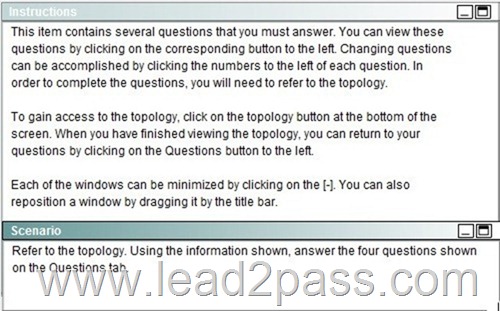

R1 is configured with the default configuration of OSPF.
From the following list of IP addresses configured on R1, which address will the OSPF process select as the router ID?
A. 192.168.0.1
B. 172.16.1.1
C. 172.16.2.1
D. 172.16.2.225
Answer: A
Explanation:
The Router ID (RID) is an IP address used to identify the router and is chosen using the following sequence:
+ The highest IP address assigned to a loopback (logical) interface.
+ If a loopback interface is not defined, the highest IP address of all active router’s physical interfaces will be chosen.
+ The router ID can be manually assigned
In this case, because a loopback interface is not configured so the highest active IP address 192.168.0.1 is chosen as the router ID.
QUESTION 92
Hotspot Question 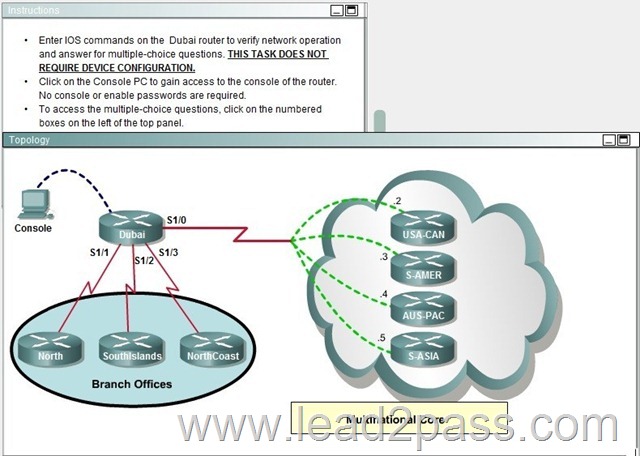

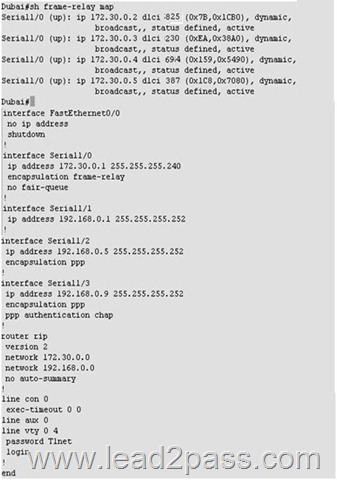
If required, what password should be configured on the DeepSouth router in the branch office to allow a connection to be established with the MidEast router?
A. No password is required.
B. Enable
C. Secret
D. Telnet
E. Console
Answer: B
Explanation:
In the diagram, DeepSouth is connected to Dubai’s S1/2 interface and is configured as follows:
Interface Serial1/2
IP address 192.168.0.5 255.255.255.252
Encapsulalation PPP ; Encapsulation for this interface is PPP
Check out the following Cisco Link:
http://www.cisco.com/en/US/tech/tk713/tk507/technologies_configuration_example09186a0080094333.shtml#configuringausernamedifferentfromtheroutersname
Here is a snipit of an example:
Network Diagram
If Router 1 initiates a call to Router 2, Router 2 would challenge Router 1, but Router 1 would not challenge Router 2. This occurs because the ppp authentication chap callin command is configured on Router 1. This is an example of a unidirectional authentication. In this setup, the ppp chap hostname alias-r1 command is configured on Router 1. Router 1 uses “alias-r1” as its hostname for CHAP authentication instead of “r1.” The Router 2 dialer map name should match Router 1’s ppp chap hostname; otherwise, two B channels are established, one for each direction.
QUESTION 93
Hotspot Question 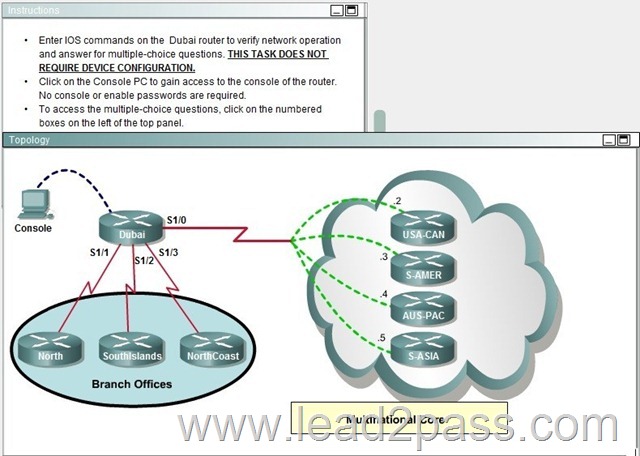
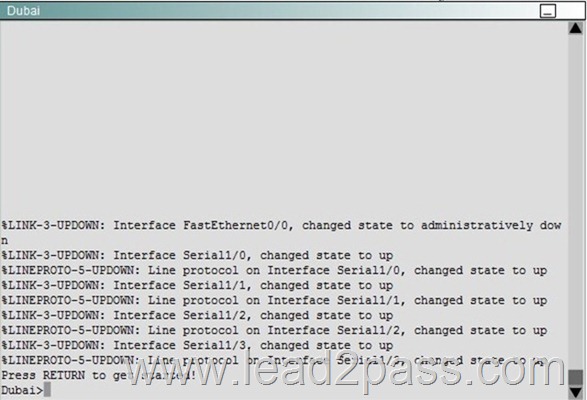
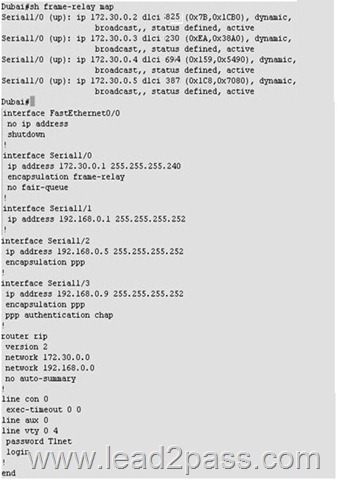
What would be the destination Layer 2 address in the frame header for a frame that is being forwarded by Dubai to the host address of 172.30.4.4?
A. 825
B. 230
C. 694
D. 387
Answer: C
Explanation:
According to command output 172.30.4.4 is using the 694 dlci value. http://www.cisco.com/en/US/docs/ios/12_2/wan/command/reference/wrffr4.html#wp1029343
QUESTION 94
Hotspot Question 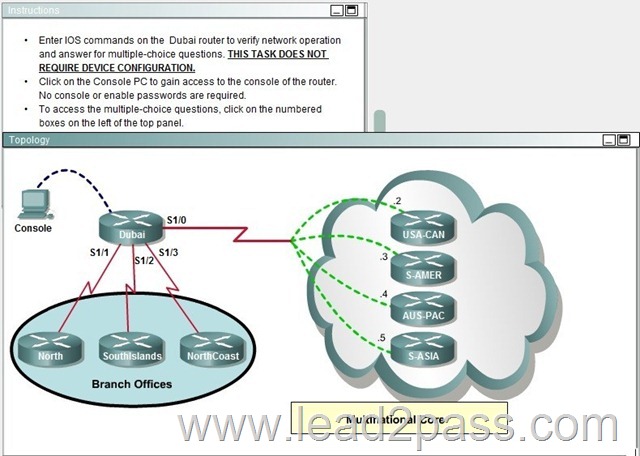
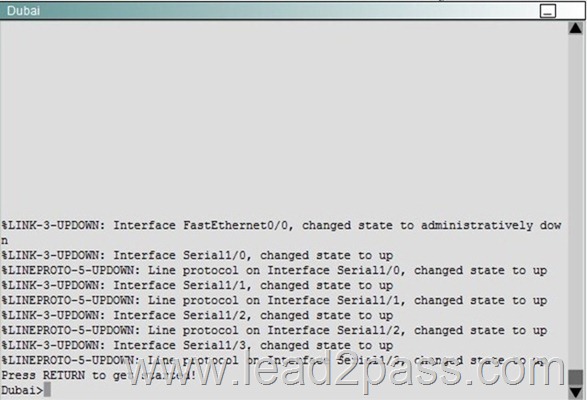
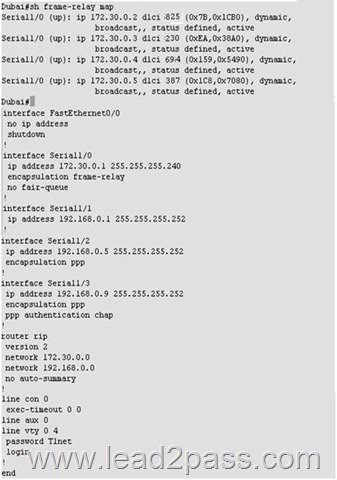
Which connection uses the default encapsulation for serial interfaces on Cisco routers?
A. The serial connection to the NorthCoast branch office.
B. The serial connection to the North branch office.
C. The serial connection to the Southlands branch office.
D. The serial connection to the Multinational Core.
Answer: B
Explanation:
Cisco default encapsulation is HDLC which is by default enabled on all cisco router. If we want to enable other encapsulation protocol(PPP,X.25 etc) we need to define in interface setting. But here except s1/1 all interface defined by other encapsulation protocol so we will assume default encapsulation running on s1/1 interface and s1/1 interface connected with North
QUESTION 95
Hotspot Question
A static map to the S-AMER location is required.
Which command should be used to create this map? 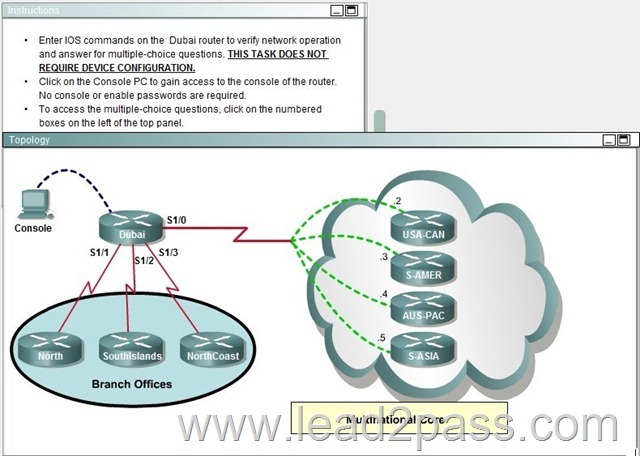
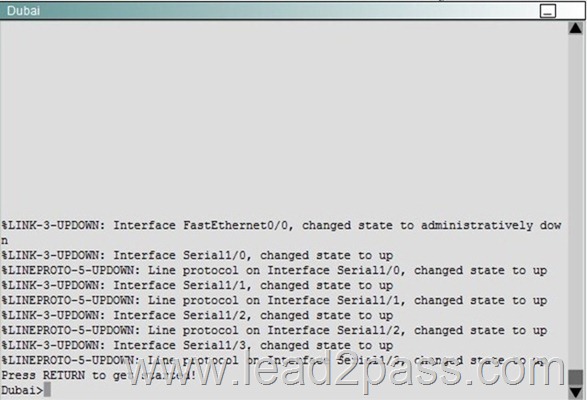
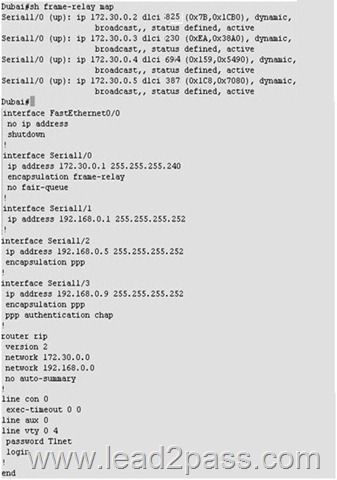
A. frame-relay map ip 172.30.0.3 825 broadcast
B. frame-relay map ip 172.30.0.3 230 broadcast
C. frame-relay map ip 172.30.0.3 694 broadcast
D. frame-relay map ip 172.30.0.3 387 broadcast
Answer: B
Explanation:
frame-relay map ip 172.30.0.3 230 broadcast 172.30.0.3 is S-AMER router ip address and its configure on 230 dlci value. Check “show frame-relay map ” output in the diagram.
QUESTION 96
Lab – VTP Configuration
A new switch is being added to the River Campus LAN. You will work to complete this process by first configuring the building_210 switch with an IP address and default gateway. For the switch host address, you should use the last available IP address on the management subnet. In addition, the switch needs to be configured to be in the same VTP domain as the building_100 switch and also needs to be configured as a VTP client. Assume that the IP configuration and VTP configuration on building_100 are complete and correct.
The configuration of the router is not accessible for this exercise. You must accomplish the following tasks:
Determine and configure the IP host address of the new switch.
Determine and configure the default gateway of the new switch.
Determine and configure the correct VTP domain name for the new switch.
Configure the new switch as a VTP client. 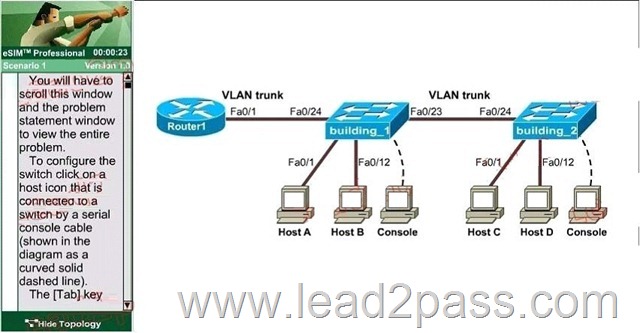
Answer:
Here are the Steps for this Lab Solution:
The question states we can’t access the router so we can only get required information from switch building_1. Click on the PC connected with switch building_1 (through a console line) to access switch building_1s CLI. On this switch use the show running-config command:
building_1#show running-config
Next use the show vtp status command to learn about the vtp domain on this switch
building_1#show vtp status
(Notice: the IP address, IP default-gateway and VTP domain name might be different!!!) You should write down these 3 parameters carefully.
Configuring the new switch
+ Determine and configure the IP host address of the new switch The question requires “for the switch host address, you should use the last available IP address on the management subnet”. The building_1 switch’s IP address, which is 192.168.22.50 255.255.255.224, belongs to the management subnet.
Increment: 32 (because 224 = 1110 0000)
Network address: 192.168.22.32
Broadcast address: 192.168.22.63
->The last available IP address on the management subnet is 192.168.22.62 and it hasn’t been used (notice that the IP address of Fa0/1 interface of the router is also the default gateway address 192.168.22.35).
Also notice that the management IP address of a switch should be configured in Vlan1 interface. After it is configured, we can connect to it via telnet or SSH to manage it.
Switch2#configure terminal
Switch2(config)#interface Vlan1
Switch2(config-if)#ip address 192.168.22.62 255.255.255.224
Switch2(config-if)#no shutdown
+ Determine and configure the default gateway of the new switch The default gateway of this new switch is same as that of building_1 switch, which is 192.168.22.35
Switch2(config-if)#exit
Switch2(config)#ip default-gateway 192.168.22.35
+ Determine and configure the correct VTP domain name for the new switch The VTP domain name shown on building_1 switch is Cisco so we have to use it in the new switch (notice: the VTP domain name will be different in the exam and it is case sensitive so be careful) Switch2(config)# vtp domain Cisco
+ Configure the new switch as a VTP client
Switch2(config)#vtp mode client
We should check the new configuration with the “show running-config” & “show vtp status”; also try pinging from the new switch to the the default gateway to make sure it works well.
Finally save the configuration
Switch2(config)#exit
Switch2#copy running-config startup-config
QUESTION 97
Lab – NAT
A network associate is configuring a router for the weaver company to provide internet access. The ISP has provided the company six public IP addresses of 198.18.184.105 198.18.184.110. The company has 14 hosts that need to access the internet simultaneously.
The hosts in the company LAN have been assigned private space addresses in the range of 192.168.100.17 – 192.168.100.30.
The following have already been configured on the router 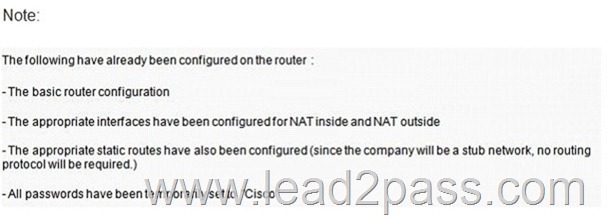
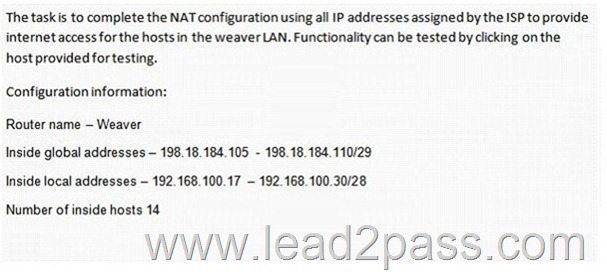
Answer:
The above named organisation has 14 hosts that need to access the internet simultaneously but were provided with just 6 public IP addresses from198.18.184.105 to 198.18.184.110/29.
In this case, you have to consider using NAT Overload (or PAT)
Doubleclick on the Weaver router to access the CLI
Router> enable
Router# configure terminal
First you should change the router’s name to Weaver:
Router(config)#hostname Weaver
Create a NAT pool of global addresses to be allocated with their netmask:
Weaver(config)# ip nat pool mypool 198.18.184.105 198.18.184.110 netmask 255.255.255.248
Create a standard access control list that permits the addresses that are to be translated:
Weaver(config)#access-list 1 permit 192.168.100.16 0.0.0.15
Establish dynamic source translation, specifying the access list that was defined in the prior step:
Weaver(config)#ip nat inside source list 1 pool mypool overload
Finally, we should save all your work with the following command:
Weaver#copy running-config startup-config (Don’t forget this)
Check your configuration by going to “Host for testing” and type:
C : \ >ping 192.0.2.114
The ping should work well and you will be replied from 192.0.2.114
This command translates all source addresses that pass access list 1, which means a source address from 192.168.100.17 to 192.168.100.30, into an address from the pool named mypool (the pool contains addresses from 198.18.184.105 to 198.18.184.110) Overload keyword allowsto map multiple IP addresses to a single registered IP address (many-to- one) by using different ports.
The question said that appropriate interfaces have been configured for NAT inside and NAT outside statements.
This is how to configure the NAT inside and NAT outside, just for your understanding:
Weaver(config)#interface fa0/0
Weaver(config-if)#ip nat inside
Weaver(config-if)#exit
Weaver(config)#interface s0/0
Weaver(config-if)#ip nat outside
Weaver(config-if)#end
QUESTION 98
Lab – OSPF 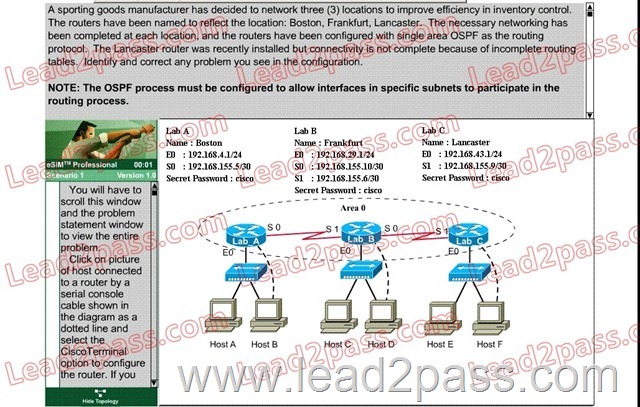
Answer:
The question mentioned Boston router was not configured correctly or incomplete so we should check this router first. Click on PC-B to access the command line interface (CLI) of Boston router.
Boston>enable (type cisco as its password here)
Boston#show running-config 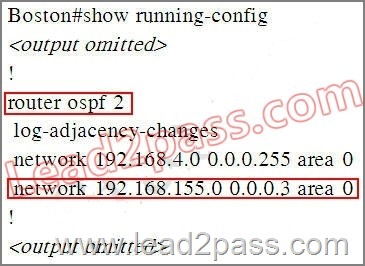
First, remember that the current OSPF Process ID is 2 because we will need it for later configuration. Next notice that in the second “network” command the network and wildcard mask are 192.168.155.0 and 0.0.0.3 which is equivalent to 192.168.155.0 255.255.255.252 in term of subnet mask. Therefore this subnetwork’s range is from 192.168.155.0 to 192.168.155.3 but the ip address of s0/0 interface of Boston router is192.168.155.5 which don’t belong to this range -> this is the reason why OSPF did not recognize s0 interface of Boston router as a part of area 0. So we need to find a subnetwork that s0 interface belongs to.
IP address of S0 interface: 192.168.155.5/30
Subnet mask: /30 = 1111 1111.1111 1111.1111 1111.1111 1100
Increment: 4
Network address (which IP address of s0 interface belongs to): 192.168.155.4 (because 4 * 1 = 4 < 5)
Therefore we must use this network instead of 192.168.155.0 network
Boston#configure terminal
Boston(config)#router ospf 2
Boston(config-router)#no network 192.168.155.0 0.0.0.3 area 0
Boston(config-router)#network 192.168.155.4 0.0.0.3 area 0
Boston(config-router)#end
Boston#copy running-config startup-config
Finally, you should issue a ping command from Boston router to Lancaster router to make sure it works well.
Boston#ping 192.168.43.1
QUESTION 99
Lab – Access List Simulation 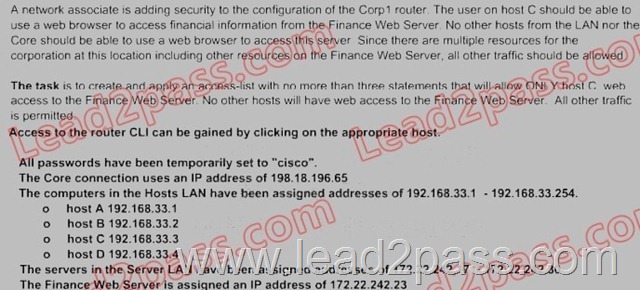
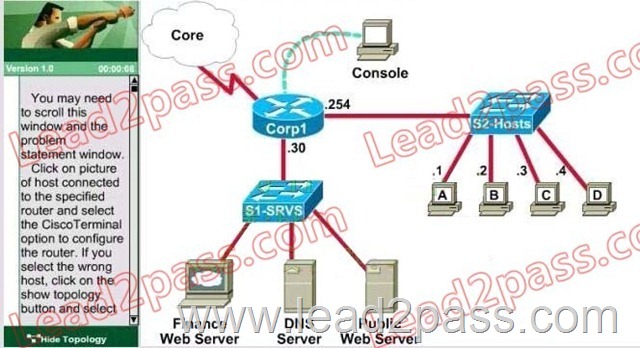
Answer:
Corp1#configure terminal
Corp1(config)#interface s1/0
Corp1(config-if)#ip add 198.18.196.65 255.255.255.252
Corp1(config-if)#end
Corp1>enable
Corp1#show running-config
Corp1#configure terminal
Corp1(config)#access-list 100 permit tcp host 192.168.33.3 host 172.22.242.23 eq 80
Corp1(config)#access-list 100 deny tcp any host 172.22.242.23 eq 80
Corp1(config)#access-list 100 permit ip any any
Corp1(config)#interface fa0/1
Corp1(config-if)#ip access-group 100 out
Corp1(config-if)#end
Corp1#copy running-config startup-config
Explanation :
Select the console on Corp1 router
Configuring ACL
Corp1>enable
Corp1#configure terminal
Comment: To permit only Host C (192. 168. 33. 3){source addr} to access finance server address (172. 22.242. 23){destination addr} on port number 80 (web)
Corp1(config)# access-list 100 permit tcp host 192.168.33.3 host 172.22.242.23 eq 80
Comment: To deny any source to access finance server address (172. 22. 242. 23) {destination addr} on port number 80 (web)
Corp1(config)# access-list 100 deny tcp any host 172.22.242.23 eq 80
Comment: To permit ip protocol from any source to access any destination because of the implicit deny any any statement at the end of ACL.
Corp1(config)# access-list 100 permit ip any any
Applying the ACL on the Interface
Comment: Check show ip interface brief command to identify the interface type and number by checking the IP address configured.
Corp1(config)#interface fa 0/1
If the ip address configured already is incorrect as well as the subnet mask. this should be corrected in order ACL to work type this commands at interface mode :
no ip address 192. x. x. x 255. x. x. x (removes incorrect configured ip address and subnet mask) Configure Correct IP Address and subnet mask :
ip address 172. 22. 242. 30 255. 255. 255. 240 ( range of address specified going to server is given as 172. 22. 242. 17 172. 22. 242. 30 )
Comment: Place the ACL to check for packets going outside the interface towards the finance web server.
Corp1(config-if)#ip access-group 100 out
Corp1(config-if)#end
Important: To save your running config to startup before exit.
Corp1#copy running-config startup-config
Verifying the Configuration :
Step1: Show ip interface brief command identifies the interface on which to apply access list .
Step2: Click on each host A,B,C & D . Host opens a web browser page , Select address box of the web browser and type the ip address of finance web server(172. 22. 242. 23) to test whether it permits /deny access to the finance web Server.
QUESTION 100
Lab – CLI Configuration 
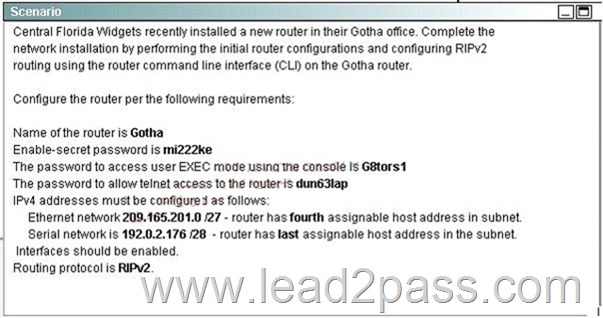

Attention:
In practical examinations, please note the following, the actual information will prevail.
1. Name of the router is xxx
2. Enable. secret password is xxx
3. Password In access user EXEC mode using the console is xxx
4. The password to allow telnet access to the router is xxx
5. IP information
Answer:
Router>enable
Router#config terminal
Router(config)#hostname Gotha
Gotha(config)#enable secret mi222ke
Gotha(config)#line console 0
Gotha(config-line)#password G8tors1
Gotha(config-line)#exit
Gotha(config)#line vty 0 4
Gotha(config-line)#password dun63lap
Gotha(config-line)#login
Gotha(config-line)#exit
Gotha(config)#interface fa0/0
Gotha(config-if)#no shutdown
Gotha(config-if)#ip address 209.165.201.4 255.255.255.224
Gotha(config)#interface s0/0/0
Gotha(config-if)#ip address 192.0.2.190 255.255.255.240
Gotha(config-if)#no shutdown
Gotha(config-if)#exit
Gotha(config)#router rip
Gotha(config-router)#version 2
Gotha(config-router)#network 209.165.201.0
Gotha(config-router)#network 192.0.2.176
Gotha(config-router)#end
Gotha#copy run start
Lead2pass Cisco 200-105 exam dumps are audited by our certified subject matter experts and published authors for development. Lead2pass Cisco 200-105 exam dumps are one of the highest quality Cisco 200-105 Q&As in the world. It covers nearly 96% real questions and answers, including the entire testing scope. Lead2pass guarantees you pass Cisco 200-105 exam at first attempt.
200-105 new questions on Google Drive: https://drive.google.com/open?id=0B3Syig5i8gpDY2V1UExCV21ZUHM
2016 Cisco 200-105 exam dumps (All 346 Q&As) from Lead2pass:
http://www.lead2pass.com/200-105.html [100% Exam Pass Guaranteed]